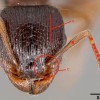Abstract
The pavement ant is one of the most commonly encountered ants in the United States. Since first introduced from Europe at the beginning of the nineteenth century, the ant has become well established and is prevalent in urban areas in the northern U.S. and parts of Canada. However, the extent of their invasiveness and severity as a pest is not well characterized. This 5-page fact sheet was written by Tyler Vitone and Andrea Lucky, and published by the UF Department of Entomology and Nematology, September 2014.
References
Attygalle AB, Morgan ED. 1983. Trail pheromone of the ant Tetramorium caespitum L. Naturwissenschaften 70: 364-365. https://doi.org/10.1007/BF00444215
Bharti H, Kumar R. 2012. Taxonomic studies on genus Tetramorium Mayr (Hymenoptera, Formicidae) with report of two new species and three new records including a tramp species from India with a revised key. ZooKeys 207: 11. https://doi.org/10.3897/zookeys.207.3040
Brian MV, Elmes GW. 1974. Production by the ant Tetramorium caespitum in a southern English heath. The Journal of Animal Ecology 43: 889-893. https://doi.org/10.2307/3542
Bruder KW, Gupta AP. 1972. Biology of the pavement ant, Tetramorium caespitum (Hymenoptera: Formicidae). Annals of the Entomological Society of America 65: 358-367. https://doi.org/10.1093/aesa/65.2.358
Buczkowski G, Richmond DS. 2012. The effect of urbanization on ant abundance and diversity: A temporal examination of factors affecting biodiversity. PloS One 7: e41729. https://doi.org/10.1371/journal.pone.0041729
Dash ST, Sanchez L. 2009. New distribution record for the social parasitic ant Anergates atratulus (Schenck, 1852) (Hymenoptera: Formicidae): An IUCN Red-Listed species. Western North American Naturalist 69: 140-141. https://doi.org/10.3398/064.069.0109
Ellison AM, Gotelli NJ, Farnsworth EJ, Alpert GD. 2012. A field guide to the ants of New England. Yale University Press. p. 332.
Fiedler K, Maschwitz U. 1988. Functional analysis of the myrmecophilous relationships between ants (Hymenoptera: Formicidae) and lycaenids (Lepidoptera: Lycaenidae). Oecologia 75: 204-206. https://doi.org/10.1007/BF00378598
Fisher BL, Cover SP. 2007. Ants of North America: A guide to the genera. University of California Press. pp. 25-40, 148-159. https://doi.org/10.1525/9780520934559
Garcia, FH, Fisher, BL. 2014. The hyper-diverse ant genus Tetramorium Mayr (Hymenoptera, Formicidae) in the Malagasy region taxonomic revision of the T. naganum, T. plesiarum, T. schaufussii, and T. severini species groups. ZooKeys 413: 1-170. https://doi.org/10.3897/zookeys.413.7172
Katayama N, Suzuki N. 2003. Bodyguard effects for aphids of Aphis craccivora Koch (Homoptera: Aphididae) as related to the activity of two ant species, Tetramorium caespitum Linnaeus (Hymenoptera: Formicidae) and Lasius niger L. (Hymenoptera: Formicidae). Applied Entomology and Zoology 38: 427-433. https://doi.org/10.1303/aez.2003.427
King TG, Phillips Jr SA. 1992. Destruction of young colonies of the red imported fire ant by the pavement ant (Hymenoptera: Formicidae). Entomological News 103: 72-77.
Lessard JP, Buddle CM. 2005. The effects of urbanization on ant assemblages (Hymenoptera: Formicidae) associated with the Molson Nature Reserve, Quebec. Canadian Entomologist 137: 215-225. https://doi.org/10.4039/n04-055
Merickel FW, Clark WH. 1994. Tetramorium caespitum (Linnaeus) and Liometopum luctuosum WM Wheeler (Hymenoptera: Formicidae): New state records for Idaho and Oregon, with notes on their natural history. Pan-Pacific Entomologist 70: 148-158.
Pećarević M, Danoff-Burg J, Dunn RR. 2010. Biodiversity on Broadway-enigmatic diversity of the societies of ants (Formicidae) on the streets of New York City. PLoS One 5: e13222. https://doi.org/10.1371/journal.pone.0013222
Schlick-Steiner BC, Steiner FM, Moder K, Seifert B, Sanetra M, Dyreson E, Staffer C, Christian E. 2006. A multidisciplinary approach reveals cryptic diversity in Wester Palearctic Tetramorium ants (Hymenoptera: Formicidae). Molecular Phylogenetics and Evolution 40: 259-273. https://doi.org/10.1016/j.ympev.2006.03.005
Sharaf MR, Aldawood AS, Taylor B. 2012. A new ant species of the genus Tetramorium Mayr, 1855 (Hymenoptera: Formicidae) from Saudi Arabia, with a revised key to the Arabian species. PLoS One 7: e30811. https://doi.org/10.1371/journal.pone.0030811
Shen JX, Xu ZM, Hankes E. 1998. Direct homing behaviour in the ant Tetramorium caespitum (Formicidae, Myrmicinae). Animal Behaviour 55: 1443-1450. https://doi.org/10.1006/anbe.1997.0718
Steiner FM, Schlick-Steiner BC, VanDerWal J, Reuther KD, Christian E, Stauffer C, Suarez A, Williams S, Crozier RH. 2008. Combined modelling of distribution and niche in invasion biology: A case study of two invasive Tetramorium ant species. Diversity and Distributions 14: 538-545. https://doi.org/10.1111/j.1472-4642.2008.00472.x
Vanek SJ, Potter DA. 2010. An interesting case of ant-created enemy-free space for magnolia scale (Hemiptera: Coccidae). Journal of Insect Behavior 23: 389-395. https://doi.org/10.1007/s10905-010-9221-0
Wild A. 2014. How to tell the difference between the Japanese pavement ant and the common pavement ant. www.myrmecos.net. (1 May 2014). Retrieved from http://www.myrmecos.net/2014/04/21/how-to-tell-the-difference-between-the-japanese-pavement-ant-and-the-common-pavement-ant/

